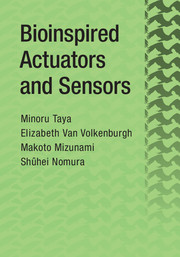Refine search
Actions for selected content:
2002 results in Engineering design, kinematics, and robotics
4 - From Stand-Alone Solutions to Systems Integrated by Structured Environments
-
- Book:
- Construction Robots
- Published online:
- 27 January 2017
- Print publication:
- 24 October 2016, pp 302-304
-
- Chapter
- Export citation
Copyright page
-
- Book:
- Construction Robots
- Published online:
- 27 January 2017
- Print publication:
- 24 October 2016, pp iv-iv
-
- Chapter
- Export citation
1 - Introduction
-
- Book:
- Construction Robots
- Published online:
- 27 January 2017
- Print publication:
- 24 October 2016, pp 1-13
-
- Chapter
- Export citation
Contents
-
- Book:
- Construction Robots
- Published online:
- 27 January 2017
- Print publication:
- 24 October 2016, pp v-vi
-
- Chapter
- Export citation
References
-
- Book:
- Construction Robots
- Published online:
- 27 January 2017
- Print publication:
- 24 October 2016, pp 305-314
-
- Chapter
- Export citation

Bioinspired Actuators and Sensors
-
- Published online:
- 20 October 2016
- Print publication:
- 13 October 2016
Appendix E: - Modeling of effective magnetic properties of ferromagnetic shape memory alloy (FSMA) composite
-
- Book:
- Bioinspired Actuators and Sensors
- Published online:
- 20 October 2016
- Print publication:
- 13 October 2016, pp 483-485
-
- Chapter
- Export citation
Copyright page
-
- Book:
- Bioinspired Actuators and Sensors
- Published online:
- 20 October 2016
- Print publication:
- 13 October 2016, pp iv-iv
-
- Chapter
- Export citation
Acknowledgments
-
- Book:
- Bioinspired Actuators and Sensors
- Published online:
- 20 October 2016
- Print publication:
- 13 October 2016, pp xii-xiv
-
- Chapter
- Export citation
Contents
-
- Book:
- Bioinspired Actuators and Sensors
- Published online:
- 20 October 2016
- Print publication:
- 13 October 2016, pp v-viii
-
- Chapter
- Export citation
Appendix B: - Analytical modeling of displacement and blocking force of a laminate dielectric (DE) bending actuator
-
- Book:
- Bioinspired Actuators and Sensors
- Published online:
- 20 October 2016
- Print publication:
- 13 October 2016, pp 470-473
-
- Chapter
- Export citation
1 - Introduction
-
- Book:
- Bioinspired Actuators and Sensors
- Published online:
- 20 October 2016
- Print publication:
- 13 October 2016, pp 1-5
-
- Chapter
- Export citation
Author Index
-
- Book:
- Bioinspired Actuators and Sensors
- Published online:
- 20 October 2016
- Print publication:
- 13 October 2016, pp 512-518
-
- Chapter
- Export citation
2 - Principles of structural organization and functions in biological species
-
- Book:
- Bioinspired Actuators and Sensors
- Published online:
- 20 October 2016
- Print publication:
- 13 October 2016, pp 6-43
-
- Chapter
- Export citation
Appendices
-
- Book:
- Bioinspired Actuators and Sensors
- Published online:
- 20 October 2016
- Print publication:
- 13 October 2016, pp 459-485
-
- Chapter
- Export citation
Appendix D: - Analytical model for SMA fiber/Al matrix composite
-
- Book:
- Bioinspired Actuators and Sensors
- Published online:
- 20 October 2016
- Print publication:
- 13 October 2016, pp 478-482
-
- Chapter
- Export citation
6 - Bio-inspired designs of sensors, actuators
-
- Book:
- Bioinspired Actuators and Sensors
- Published online:
- 20 October 2016
- Print publication:
- 13 October 2016, pp 369-435
-
- Chapter
- Export citation
Subject Index
-
- Book:
- Bioinspired Actuators and Sensors
- Published online:
- 20 October 2016
- Print publication:
- 13 October 2016, pp 519-524
-
- Chapter
- Export citation
References
-
- Book:
- Bioinspired Actuators and Sensors
- Published online:
- 20 October 2016
- Print publication:
- 13 October 2016, pp 486-511
-
- Chapter
- Export citation
Appendix C: - Polymer gel modeling, calculation of potentials in regions I-III in Nafion-based IPMC
-
- Book:
- Bioinspired Actuators and Sensors
- Published online:
- 20 October 2016
- Print publication:
- 13 October 2016, pp 474-477
-
- Chapter
- Export citation
